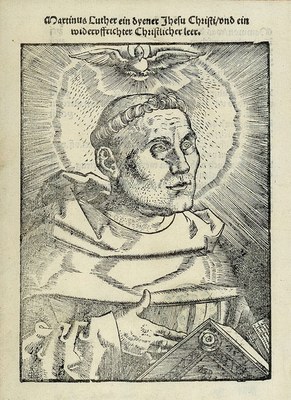Luther Portraits Influenced by Cranach
![Doctor Martini Luthers offenliche Verhör IMG Doctor Martini Luthers offent=||liche verho[e]r zu[e] Worms im[m] Reychstag/||Red vnnd widerred/am.17.tag||Aprilis/im[m] jar.1521.||beschehen, Titelblatt, Holzschnitt mit Typendruck, Augsburg : Sigmund Grimm und Max Wirsung, 1521, unbekannter Augsburger Künstler; Bildquelle: VD 16 L 3653, Benzing/Claus Nr. 928, Sächsische Landesbibliothek - Staats- und Universitätsbibliothek Dresden, Hist. eccl. E 319,20, http://digital.slub-dresden.de/id350378460.](https://www.ieg-ego.eu/illustrationen/wittenberger-reformation-bilderordner/doctor-martini-luthers-offenliche-verhoer-img/@@images/c59b2784-f97c-4dc2-8221-4438b1456c22.jpeg)

The portrait by Cranach approved by the court of Electoral Saxony became the model for other artists who, however, set their own priorities and portrayed Luther as a highly-educated humanist (above) or – in a boldly "sacralizing" idealization – as a spiritually gifted Doctor of the Church (below).
above: Doctor Martini Luthers offent=||liche verho[e]r zu[e] Worms im[m] Reychstag/||Red vnnd widerred/am.17.tag||Aprilis/im[m] jar.1521.||beschehen, title page, woodcut with letterpress, Augsburg, 1521, unknown artist from Augsburg; source: VD 16 L 3653, Benzing/Claus No. 928, Sächsische Landesbibliothek - Staats- und Universitätsbibliothek Dresden, Hist. eccl. E 319,20, http://digital.slub-dresden.de/id350378460.
below: Hans Baldung Grien (1484–1545), Martin Luther unter der Taube des Heiligen Geistes, woodcut, 15.5 cm x 11.5 cm, 1521; source: Staatliche Museen zu Berlin, Kupferstichkabinett / Jörg P. Anders, https://id.smb.museum/object/1042363, public domain.